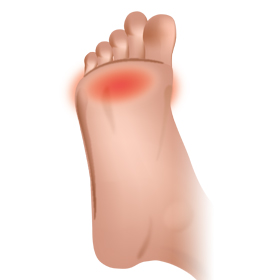 Metatarsalgia sounds very complicated and formal, but the truth is that it is just another name for foot pain. Many sufferers of Metatarsalgia experience pain in the center of their feet, between the arch and the toes. Metatarsals are 5 long bones that form part of the mid foot & the term algia refers to pain, hence the term, Metatarsalgia.
Metatarsalgia sounds very complicated and formal, but the truth is that it is just another name for foot pain. Many sufferers of Metatarsalgia experience pain in the center of their feet, between the arch and the toes. Metatarsals are 5 long bones that form part of the mid foot & the term algia refers to pain, hence the term, Metatarsalgia.
Most often, people with Metatarsalgia will complain about pain in the ball of foot area. If the foot is squeezed into a narrow shoe, or if high heels are worn, this will make this problem worse.
Foot pain can be the result of a variety of different conditions. Even a simple callus can make your feet hurt. Most people have had a callus at some point or another in their life; it is just an accumulation of dry skin that develops as a result of pressure against the bone. It is common for calluses to develop on the bottom of the feet, particularly on the heels, but is also common under the metatarsal heads (where the 5 long bones meet the toes) – i.e under the ball of foot area.
Very often, people experience foot pain because they wear uncomfortable shoes. Shoes that do not fit well and shoes that are not supportive or are shaped unnaturally can all make your feet hurt.
When you wear shoes that are too tight, they pinch and put pressure on your feet. Shoes that are too big can cause trouble, too. When your shoes are too big, there is space where the foot can move around inside the shoe. As a result, the foot can slide around, rub against the shoe, and experience friction.
If your foot pain is located on the underside of the foot, it might be an indication of an inflamed joint or a torn ligament.
Solutions
Metatarsalgia is quite common. If you are suffering from this type of pain, or any other foot pain, try these solutions. The first and most important thing that you can do is to wear comfortable, supportive shoes that fit properly.
In order to prevent foot pain, it is best to wear flat shoes without a heel. At times when you must wear high heels, choose a heel that is less than two inches tall. Instead of stilettos, choose a chunky heel with a wide base. This gives you more stability and minimizing the risk of tripping or spraining an ankle. Avoid flip flops, because they fail to give your feet any support.
Having your feet measured at least once a year is helpful. The feet often change in size over time due to weight gain, pregnancy, and aging process.
Choose sturdy shoes that provide plenty of support & when you are buying shoes, choose the proper size. Your shoes must fit well – in length and width – not too wide or too long, but with enough room for the foot to function properly. You could be wearing the wrong size shoes without realizing it. If that is the case, treating your foot pain could be a matter of simply wearing the right size shoes.
If you can’t find shoes that seem to fit your feet just right, buy shoes that have extra depth, or removable footbeds, so that an orthotic device or custom arch support can be worn inside your shoes for extra support.
Modifications can be made to shoes & arch supports, to accommodate & help relieve Metatarsalgia.
There are many types of inserts available for flat feet or high arches. You can also order custom arch supports that are made to fit your individual feet.
If you have calluses that are causing your foot pain, then you need to address the source of the pain. Calluses are caused by pressure – so removing the source of pressure – i.e by having a shoe & insert that helps to support your feet & distribute your weight more evenly, can help to minimize the development or progression of callus formation.
If you have calluses, It’s always best to seek help from a chiropodist/podiatrist. If treating calluses yourself, try soaking your feet in warm water with Epsom salts (but always seek advice from your doctor or pharmacist before doing this). After a few minutes, when the water has softened your skin, use a file or pumice stone to remove the callus. However – it will reform again over time if the cause is not taken care of. Note: Diabetics should be cautious of treating calluses etc & should always seek advice from a medical professional first.
If you experience foot pain, visit Foot Solutions. Our professionals will carry out a free foot & gait analysis, which includes measuring your feet to ensure that you are wearing the right size. We can also help you find the perfect pair of shoes from our large selection, or we can customize our shoes & arch supports to address your specific needs.
We also stock many types of over the counter arch supports, along with our custom arch supports. Call in to Foot Solutions in your area to check out our latest products and services today.
































